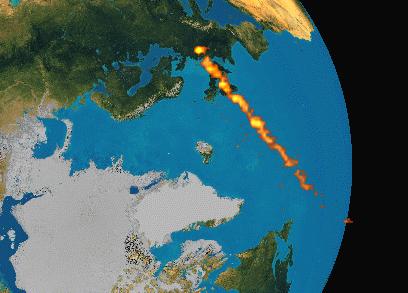A Cosmic Snowball

Explanation:
Like cosmic snowballs, fluffy comet-like objects the size of houses
and composed mostly of water-ice,
may be pummeling planet Earth 5 to 30 times a minute.
This controversial theory was originally proposed in 1986 by
Dr. Louis Frank (U. Iowa) based on data from NASA's
Dynamics Explorer 1. It is further supported by
recently reported findings from the
one year old POLAR spacecraft.
Representing a previously unknown class of Solar System objects,
these proposed small, icy comets
disintegrate in the upper atmosphere at altitudes
of 600 to 15,000 miles and so do not pose
an impact threat to the Earth's
surface or even
to spacecraft in low Earth orbit.
On breaking up, however, they produce a fleeting trail of clouds
of water vapor.
Traces of these transient, extremely high altitude clouds can be
detected by down looking spacecraft
designed to monitor the near-Earth environment.
The suspected trail of one such cosmic snowball vaporizing over the
Atlantic Ocean and Western Europe at
an altitude of 5,000 to 15,000 miles is seen above.
It was recorded in a 54 second exposure by
POLAR's Visible Imaging System in September of 1996.
A map has been added as a background for location reference.
If continuous over the history of the Earth's formation, this relatively
gentle cosmic snow shower would have been a major source of water for
Earth's present
life-nurturing oceans
and possibly even a source of simple organic compounds.
Authors & editors:
Robert Nemiroff
(MTU) &
Jerry Bonnell
(USRA)
NASA Web Site Statements, Warnings,
and Disclaimers
NASA Official: Jay Norris.
Specific
rights apply.
A service of:
LHEA at
NASA /
GSFC
& Michigan Tech. U.

